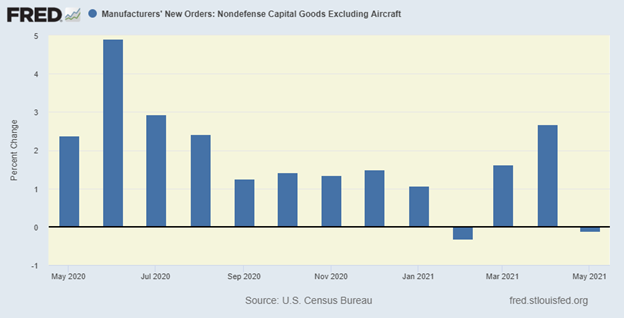The Census Bureau released an important economic report last week, and the data raises concerns about the strength of the economy: the monthly report on new orders for durable goods.
Durable goods are products designed to last at least three years. They include kitchen appliances, computers and industrial machinery used in factories.
New orders for durable goods rose 2.3% in May from April. This was lower than expectations. According to The Wall Street Journal, economists had expected a gain of 2.6%.
The report noted that “Much of that increase was due to a jump in aircraft orders, which are often lumpy.
The element of the report economists home in on to gauge capital spending plans — nondefense capital goods excluding aircraft — slipped 0.1%. Most had expected it to rise.”
This was the second time in the last four months that new orders excluding aircraft decreased.
New Durable Goods Orders Decreased

Source: Federal Reserve.
Decreased Goods Orders Could End Economic Rally
Trends in durable goods orders reflect consumer and business confidence. This is one of the few economic data reports that offer insights into both business and consumer finances.
Consumers make big purchases when they’re optimistic about the future. That’s especially true for financed purchases like new appliances or cars. Financing shows confidence in the ability to make payments.
Pessimistic consumers delay purchases. Think of your household. If you’re worried about losing your job, you probably avoid new debt. This idea applies to the larger economy. Millions of households behave that way.
These same factors affect business decisions as well. Businesses make big purchases when managers are optimistic and defer decisions when they are pessimistic.
This indicator also forecasts trends in the stock market. Avoiding the stock market when new orders are lower than they were six months ago beats a buy-and-hold strategy.
The Commerce Department began publishing this data in 1992. Selling when new orders fall avoided every significant decline since then.
New orders for durable goods tell us the economic rally could be near its end.
I’m not quitting anything…
I’m just showing people a new way to make money in the markets.
My typical approach targets setups in individual stocks. With roughly 3,000 U.S. stocks, there’s plenty of opportunity.
But my new approach has simplified everything and boiled the markets down to one repeatable trade in the same ticker symbol.
The annual return was 132% last year. Click here to see how we did it. And most importantly, how it could benefit you.
Michael Carr is a Chartered Market Technician for Banyan Hill Publishing and the Editor of One Trade, Peak Velocity Trader and Precision Profits. He teaches technical analysis and quantitative technical analysis at the New York Institute of Finance. Mr. Carr is also the former editor of the CMT Association newsletter, Technically Speaking.
Follow him on Twitter @MichaelCarrGuru.





